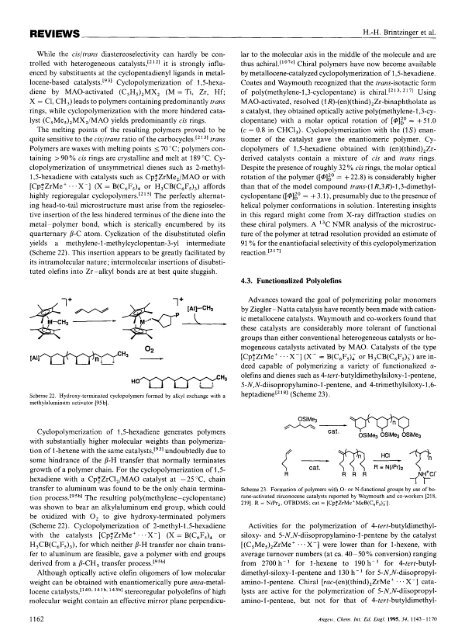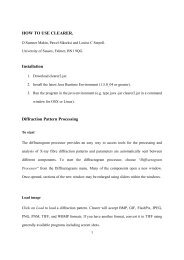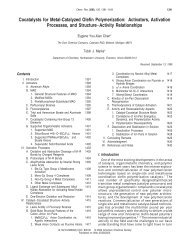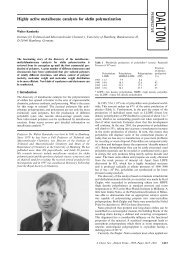Stereospecific Olefin Polymerization with Chiral Metallocene Catalysts
Stereospecific Olefin Polymerization with Chiral Metallocene Catalysts
Stereospecific Olefin Polymerization with Chiral Metallocene Catalysts
Create successful ePaper yourself
Turn your PDF publications into a flip-book with our unique Google optimized e-Paper software.
REVIEWS H.-H. Brintzinger et al.<br />
While the cisltrans diastereoselectivity can hardly be controlled<br />
<strong>with</strong> heterogeneous it is strongly influenced<br />
by substituents at the cyclopentadienyl ligands in metallocene-based<br />
catalysts.[931 Cyclopolymerization of 1,Shexadiene<br />
by MAO-activated (C,H,),MX, (M = Ti, Zr, Hf;<br />
X = C1, CH,) leads to polymers containing predominantly trans<br />
rings, while cyclopolymerization <strong>with</strong> the more hindered catalyst<br />
(C,Me,),MX,/MAO yields predominantly cis rings.<br />
The melting points of the resulting polymers proved to be<br />
quite sensitive to the cisltrans ratio of the carbocycles.[21 31 trans<br />
Polymers are waxes <strong>with</strong> melting points 570 "C; polymers containing<br />
> 90 YO cis rings are crystalline and melt at 189 "C. Cyclopolymerization<br />
of unsymmetrical dienes such as 2-methyl-<br />
1,Shexadiene <strong>with</strong> catalysts such as Cp;ZrMe,/MAO or <strong>with</strong><br />
[CpTZrMe' . . . X-] (X = B(C,F,), or H,CB(C,F,),) affords<br />
highly regioregular cyclopolymers.[21 The perfectly alternating<br />
head-to-tail microstructure must arise from the regioselective<br />
insertion of the less hindered terminus of the diene into the<br />
metal -polymer bond, which is sterically encumbered by its<br />
quarternary p-C atom. Cyclization of the disubstituted olefin<br />
yields a methylene-I-methylcyclopentan-3-yl intermediate<br />
(Scheme 22). This insertion appears to be greatly facilitated by<br />
its intramolecular nature; intermolecular insertions of disubstituted<br />
olefins into Zr-alkyl bonds are at best quite sluggish.<br />
l+ l+<br />
3%-<br />
Scheme 22. Hydroxy-terminated cyclopolymers formed by alkyl exchange <strong>with</strong> a<br />
methylaluminum activator [95 b].<br />
Cyclopolymerization of 1,5-hexadiene generates polymers<br />
<strong>with</strong> substantially higher molecular weights than polymerization<br />
of I-hexene <strong>with</strong> the same catalysts,[931 undoubtedly due to<br />
some hindrance of the p-H transfer that normally terminates<br />
growth of a polymer chain. For the cyclopolymerization of 13hexadiene<br />
<strong>with</strong> a Cp:ZrCI,/MAO catalyst at -25"C, chain<br />
transfer to aluminum was found to be the only chain termination<br />
process.[95h1 The resulting poly(methy1ene-cyclopentane)<br />
was shown to bear an alkylaluminum end group, which could<br />
be oxidized <strong>with</strong> 0, to give hydroxy-terminated polymers<br />
(Scheme 22). Cyclopolymerization of 2-methyl-1.5-hexadiene<br />
<strong>with</strong> the catalysts [CpTZrMe+ . . .X-] (X = B(C,F,), or<br />
H,CB(C,F,),), for which neither P-H transfer nor chain transfer<br />
to aluminum are feasible, gave a polymer <strong>with</strong> end groups<br />
derived from a b-CH, transfer process.[95b1<br />
Although optically active olefin oligomers of low molecular<br />
weight can be obtained <strong>with</strong> enantiomerically pure ansa-metallocene<br />
catalysts,['40. 14", 143h1 stereoregular polyolefins of high<br />
molecular weight contain an effective mirror plane perpendicu-<br />
lar to the molecular axis in the middle of the molecule and are<br />
thus a~hiral.['~~"~ <strong>Chiral</strong> polymers have now become available<br />
by metallocene-catalyzed cyclopolymerization of 1,Shexadiene.<br />
Coates and Waymouth recognized that the trans-isotactic form<br />
of poly(methylene-1,3-cyclopentane) is chiral.[2'3s U sing '<br />
MAO-activated, resolved (1 R)-(en)(thind),Zr-binaphtholate as<br />
a catalyst, they obtained optically active poly(methy1ene-I ,3-cyclopentane)<br />
<strong>with</strong> a molar optical rotation of [@]to = +51.0<br />
(c = 0.8 in CHCI,). Cyclopolymerization <strong>with</strong> the (15') enantiomer<br />
of the catalyst gave the enantiomeric polymer. Cyclopolymers<br />
of 1,Shexadiene obtained <strong>with</strong> (en)(thind),Zrderived<br />
catalysts contain a mixture of cis and trans rings.<br />
Despite the presence of roughly 32 YO cis rings, the molar optical<br />
rotation of the polymer ([@I;' = + 22.8) is considerably higher<br />
than that of the model compound trans-( 1 R,3R)-1,3-dimethylcyclopentane<br />
([@]to = + 3. l), presumably due to the presence of<br />
helical polymer conformations in solution. Interesting insights<br />
in this regard might come from X-ray diffraction studies on<br />
these chiral polymers. A I3C NMR analysis of the microstructure<br />
of the polymer at tetrad resolution provided an estimate of<br />
91 YO for the enantiofacial selectivity of this cyclopolymerization<br />
reaction.[,' 7l<br />
4.3. Funetionalized Polyolefins<br />
Advances toward the goal of polymerizing polar monomers<br />
by Ziegler -Natta catalysis have recently been made <strong>with</strong> cationic<br />
metallocene catalysts. Waymouth and co-workers found that<br />
these catalysts are considerably more tolerant of functional<br />
groups than either conventional heterogeneous catalysts or homogeneous<br />
catalysts activated by MAO. <strong>Catalysts</strong> of the type<br />
[CpTZrMe' . . . X-] (X- = B(C,F,); or H,CB(C,F,);) are indeed<br />
capable of polymerizing a variety of functionalized a-<br />
olefins and dienes such as 4-tert-butyldimethylsiloxy-1 -pentene,<br />
5-N,N-diisopropylamino-I -pentene, and 4-trimethylsiloxy-I ,6heptadieneL2I8]<br />
(Scheme 23).<br />
-<br />
cat. OSiMe3 OSiMeJ OSiMe3<br />
(T-Fm-2T<br />
R R R R<br />
Scheme 23. Formation of polymers <strong>with</strong> 0- or N-functional groups by use of bo-<br />
rdne-activated zirconocene catalysts reported by Waymouth and co-workers [218,<br />
2191. R = NiPr,, OTBDMS; cat = [Cp:ZrMe+MeB(C,F,);I<br />
7"";"'<br />
Activities for the polymerization of 4-tert-butyldimethylsiloxy-<br />
and 5-N,N-diisopropylamino-1 -pentene by the catalyst<br />
[(C,Me,),ZrMe+ . . . X-] were lower than for I-hexene, <strong>with</strong><br />
average turnover numbers (at ca. 40-50 'YO conversion) ranging<br />
from 2700 h-' for I-hexene to 190 h-' for 4-tert-butyldimethyl-siloxy-I<br />
-pentene and 130 h- ' for 5-N,N-diisopropylamino-I<br />
-pentene. <strong>Chiral</strong> [rac-(en)(thind),ZrMe+ . . . X-] catalysts<br />
are active for the polymerization of 5-N,N-diisopropylamino-I<br />
-pentene, but not for that of 4-tert-butyldimethyl-<br />
1162 Angew. Chem. Int. Ed. Engl. 1995, 34, 1143-1170






